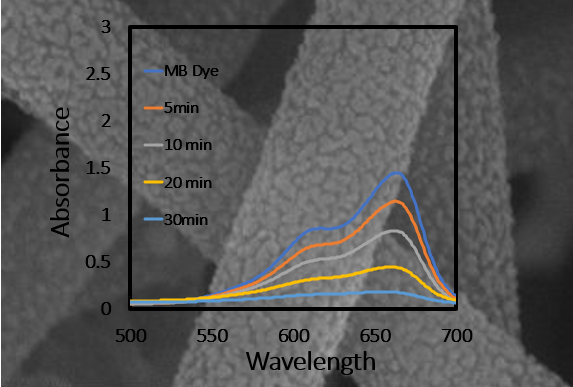
Design and synthesis of metal-titania nanomaterials for photocatalytic degradation of organic dyes in wastewater
Abstract:
Water pollution poses a major threat to the environment. To mitigate the harmful effects of textile effluents on potable water, and flora and fauna ecosystems, various techniques have been developed to treat wastewater before discharging it to the environment. Among the various approaches developed to treat industrial wastewater (containing organic dyes), dye photocatalytic degradation of industrial effluents has emerged as one of the most favorable methodologies. Photocatalysis is appealing for its inexpensive, eco-friendly, and sustainable potential. Nanoparticles of transition metals, and their oxides are among the most widely used photocatalytic materials for a wide variety of applications. Titania nanoparticles due to their low-cost, good optical properties, tunable bandgap, excellent thermal and chemical stabilities have attracted huge interest for the low-cost photocatalytic water remediation applications. Despite these advantages, however, several challenges remain unsolved before these materials can be extensively used. These include improved visible light absorption, better electron-hole pair separation, and porous nanostructures with high surface areas. Although, TiO2 NPs are quite effective in degrading organic dyes in wastewaters, however, removal of these particles from the treated water remains an issue for their sustainable use. To overcome these challenges, the synthesis of highly porous Titania nanomaterials decorated with metal nanoparticles showing surface plasmon resonance is being explored. The main focus of this project is to design photoactive catalysts that possess inherent porosity with high surface area, and charge separation properties for visible-light mediated degradation of dyes in wastewater. We successfully synthesized TiO2 fibers by electrospinning process using PVP (polyvinyl Pyrrolidine) as a binder. The resulting nanofibers were calcined to create desired porosity by burning off the organic binder. These fibers were then decorated with a controlled amount of gold nanoparticles. These composite materials were used to photo catalytically degrade methylene blue dye. Results of the degradation study show that the rate of dye degradation is significantly enhanced by the deposition of gold nanoparticles as compared to that of bare fiber. Enhanced dye degradation by the gold decorated nanomaterials is linked to the enhanced light absorption and lower electron-hole pairs recombination. These materials will be characterized by SEM, BET, TGA, and XRD analysis.
Thesis Committee
- Dr. Habib-ur-Rehman (supervisor)
- Dr. Irshad Hussain (thesis committee member/evaluator)
- Dr. Muhammad Zaheer (thesis committee member/evaluator)

